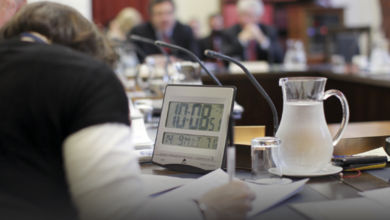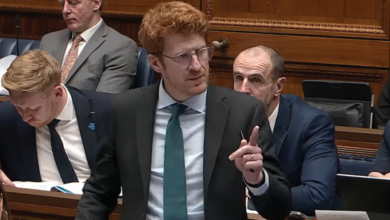Proposal: By-elections under STV

The Alliance Party’s Scott Moore outlines his proposal for a ‘fairer’ by-election system in Northern Ireland.
In Northern Ireland’s assembly and councils, when a politician dies or resigns, their party appoints a replacement. This is called co-option. It contrasts with the UK Parliament, which uses by-elections in an MP’s constituency when they die or resign. This has meant up to one-fifth of MLAs can end up being appointed by parties, and not being directly elected by voters. A fifth of MLAs is enough to swing many Assembly votes. Some resignations were due to illness, but others seemed to be because the MLA no longer wanted to serve, perhaps for career-related reasons.
Many co-options mightn’t have happened if parties faced a by-election, and a resignation meant a risk of losing the seat. By-elections are held in the Republic of Ireland to fill vacancies in Dáil Éireann. But because the Republic of Ireland uses STV, by-elections favour the largest party in the constituency, and can change the political balance of a constituency mid-term. As the Assembly and councils also use STV, this was why it was decided by-elections should not be held for these bodies.
This proposal is a version of STV which would allow for fair by-elections to be held for the Northern Ireland Assembly, its councils, and any body which uses STV. Its core principle is that the makeup of seats post-election should reflect the results of the by-election.
For example, in an ordinary STV by-election, if PBP MLA Gerry Carroll resigned his West Belfast seat, the quota in the resulting by-election would be 50 per cent. Sinn Féin would win, while Carroll’s replacement would languish behind, even if all parties got the same vote as previously. The makeup of the constituency would be five Sinn Féin MLAs, yet in an ordinary election, Sinn Féin only have enough votes for four.
Key here is preventing ‘double-spending’ of votes. That is, if an elector’s vote contributes to the election of a candidate in the ordinary election, the value of that vote shouldn’t also count towards electing a candidate in a by-election. But if a voter’s preferred candidate dies or resigns, the value of their vote should count in the resulting by-election. Thus, we need a by-election method where candidates have an incentive to maintain their vote, while trying to win over people who had voted for the politician who has died or resigned, or people who did not vote or transfer to any politician who succeeded in getting elected previously.
The ideas of the method are different quotas (the proportion of the overall vote needed to get elected) for each candidate, depending on how many seats their party already holds in the area; penalties, to tackle double-spending of votes; eliminating candidates based on their percentage progress towards their own quota; and not allowing some of a party’s votes to be transferred if it already has seats in the area.
The penalties stop double-spending of votes, by stopping certain votes from being counted if it is estimated that those votes contributed to a candidate being elected the last time round, unless that candidate has since died or resigned. These estimations are made in such a way that it will be minimally different to the actual double-spending that has happened. However, unless we abolish the secret ballot, we can’t guarantee a perfectly fair by-election under STV. Despite this, I believe this system allows for the closest possible approximation to fair by-elections, is much fairer than simply holding an ordinary by-election under STV, and if implemented, parties will have an incentive to use the system fairly and as intended.
The procedure
Under the proposed method, the ballots themselves would look the same as ordinary STV ballots , voters would rank the candidates 1, 2, 3 etc in order of preference. Once the votes are counted, the process would be as follows.
1 For each party, a floor will be calculated. This reflects how many votes they need to justify holding their current seats. It is equal to the size of a quota in an ordinary election in that area, multiplied by the number of seats they won at the previous ordinary election and any by-elections, plus one vote. Floors are also found for parties which won seats in those previous elections, but which didn’t stand this time. Throughout the process, they are treated as if they had stood in the election, but won 0 votes.
2 For parties below their floor, the difference between their floor and their actual vote is found. This is the ‘floor deficit’. However, the floor deficit has a maximum value of the difference between the floor at the current election, and the party’s proportion of the vote at the last election (if it would have been below the floor proportionally). However, if the party’s previous proportion of the vote would have been above their current floor proportionally, their floor deficit will be taken as 0. ‘Floor surpluses’ will also be found for each party with a vote above their floor.
3 The sum of all parties’ floor deficits will be found, and a ‘floor penalty’ will be applied to each party whose vote is above their floor. The floor penalty for each party will be a fraction of the value of the sum of the floor deficits, in proportion to how much] of the party’s vote is above their floor, as a proportion of all votes above parties’ floors. For parties standing more than one candidate (joint candidates), their party’s floor penalty will be distributed between them. A floor will be calculated for each such candidate, with each having an equal share of their party’s floor, and a floor surplus will be calculated for each. A share of the party’s floor penalty will be distributed to each candidate in proportion to each of their floor surpluses.
4 It this point, a decrease deficit would be found for each party that has fallen below their floor, and also below their previous proportion of the vote (where this previous proportion is lower than their current floor). This will be equal to the difference between their current and previous proportion of the vote (or the floor, if this is lower), with this proportion expressed in terms of number of votes in the current election.
5 The parties that are both above their floor and saw an increase in their proportion of their vote compared to the last election will be identified. Their increase value would be equal to the difference between their current and previous proportion of the vote, with this proportion expressed in terms of number of votes in the current election.
6 At this point, an increase penalty will be applied to each party that has an increase value. The increase penalty for each party will be a share of the value of the sum of decrease deficits, with each party’s share of that penalty being in proportion to their share of the sum of the increase values.
Where two or more candidates are standing for the same party, the party’s increase penalty will be distributed among these candidates. A notional previous vote for each candidate will be calculated, which will be an equal share of their party’s previous vote, and their individual increase values will be the difference between their current vote and their notional previous vote. The party’s increase penalty will be distributed to each candidate in proportion to their individual increase.
7 Quotas are calculated, determining how many votes each candidate needs to get elected. The quota would be updated at each stage of the election count if any party is standing more than one candidate. A candidate’s quota would reflect the number of ordinary election quotas they’d need to justify winning an additional seat (given the number of seats, if any, their party has won in the area in previous elections), if any joint candidates in their party are ahead of them in votes at that election, and if any joint candidates in their party have been elected so far at that election.
8 Any candidate that has met the quota will be deemed elected. If all seats have been filled, the election is over at this point. If not, all second preferences are counted, and the value of the surplus is split between the remaining candidates in proportion to the number of second preferences cast for each, as normal.
9 However, if no candidate is elected, the candidate with the least votes in proportion to their quota will be eliminated, while other candidates with a low number of votes eliminated if they could not overtake the next candidate above them in terms of votes as a proportion of quota, even if they received all preferences possible at that point.
10 Once a candidate is eliminated, the value of the candidate’s individual floor will be subtracted from the value of their votes, and the remaining value will be redistributed to other candidates in proportion to the number of immediately subsequent preferences cast across all of the eliminated candidate’s votes. The process will continue until all seats have been filled.
The system in the real world
From 2000-2018, I estimate five of the 13 by-elections would’ve produced different results under my method.
For the period 2000-2010, one-third of contested by-elections (for which full data is available) would have resulted in seats changing hands under the proposed method, compared to one-quarter under ordinary STV. However, there have not been many by-elections since 2000, so this is a low sample size – but only because many by-elections which would have happened were avoided by agreement by councils.
For comparison, there have been 64 by-elections for the UK Parliament since 2000, 15 of which (23.4 per cent) have resulted in seats changing hands.
Scott Moore is a former council election candidate for the Alliance Party from Strabane and a student of international politics and conflict studies at QUB.





